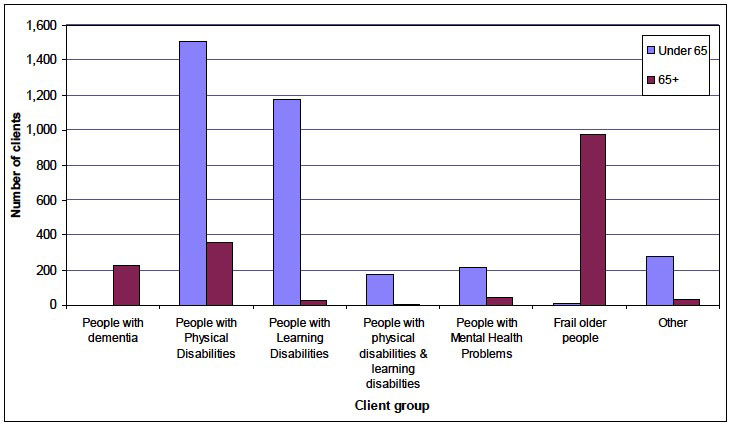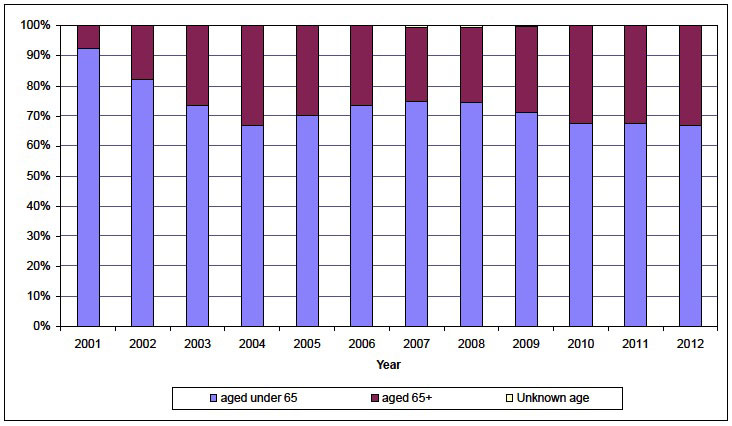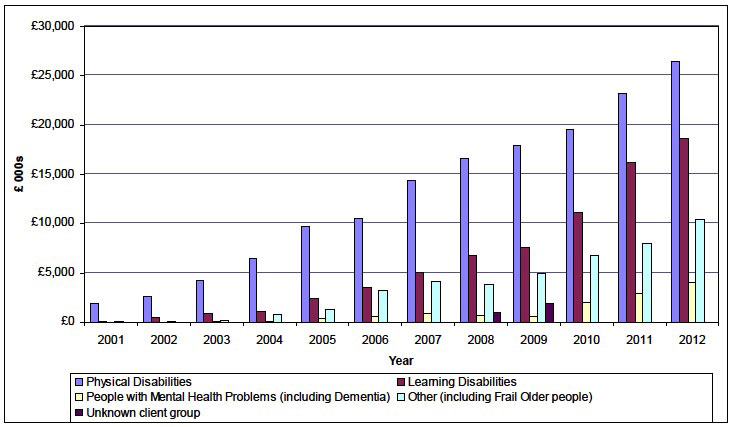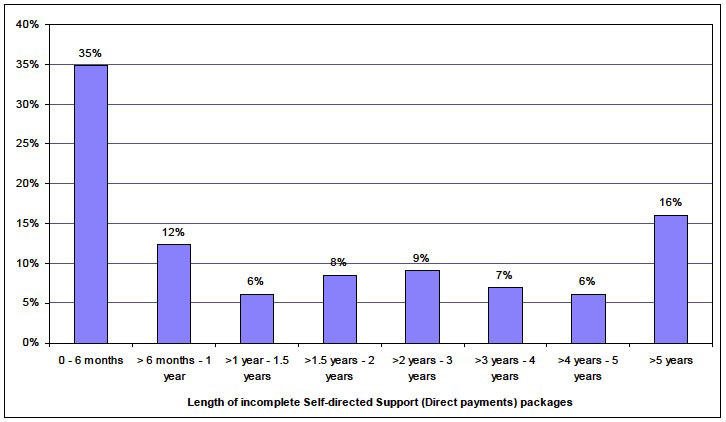Self-Directed Support (Direct Payments), Scotland, 2012
Presents the latest figures on the number of people in Scotland who use Direct Payments to purchase and manage for themselves some or all of the social care and support services they need.
This document is part of a collection
2. Scotland Analysis
Figures behind the charts are available in the annex.
- Across Scotland 5,049 people received Self-directed Support (Direct Payments) in the year 2011/12, an increase of 657 (15 per cent) from the 2010/11 level.
- 37 per cent of these 5,049 people received Self-directed Support (Direct Payments) due to a physical disability. 24 per cent had a learning disability and 4 per cent had both a learning disability and a physical disability.
Chart 2: Number of people receiving Self-directed Support (Direct payments) packages by client group and age, 2012

Chart 3: Percentage of people receiving Self-directed Support (Direct Payments) packages by age, 2001-2012

- The age profile of Self-directed Support (Direct Payment) clients has changed since 2001, with a greater proportion of recipients now aged 65 or over. In 2001 only 7 per cent of recipients were in this age group, compared to a third of clients in 2012.
- In the year to 31 March 2012, 1,663 people aged over 65 received payments (33 per cent of the total).
- Overall there were slightly more females than males in receipt of Self-directed Support (Direct Payments) in 2012, 53 per cent compared to 47 per cent.
- The age profile varies by age group. In the under 35 age groups there were more males than females using Direct Payments while in the 65 and over age group, there were nearly twice as many females than males.
Table 1: Age and gender of clients receiving Self-directed Support (Direct Payments) packages, 2012
| Age | ||||||
|---|---|---|---|---|---|---|
| 0-17 | 18-34 | 35-49 | 50-64 | 65+ | Total | |
| Male | 448 | 678 | 328 | 386 | 556 | 2,396 |
| Female | 249 | 421 | 422 | 454 | 1,107 | 2,653 |
| Total | 697 | 1,099 | 750 | 840 | 1,663 | 5,049 |
Source: Self-directed Support (Direct Payments) Survey, Scottish Government
Table 2: Ethnicity of clients receiving Self-directed Support (Direct Payments) packages, 2012
| Ethnicity | Number of clients |
|---|---|
| White | 4,001 |
| Mixed or multiple ethnic groups | 14 |
| Asian | 50 |
| African, Caribbean or Black | 12 |
| Other ethnic background | 28 |
| Not disclosed | 85 |
| Not known | 859 |
| All | 5,049 |
Source: Self-directed Support (Direct Payments) Survey, Scottish Government
- In the year to 31 March 2012, 97 per cent of the people who received payments and their Ethnicity was known, were of White ethnicity (4,001 people).
Chart 4: Value of Self-directed Support (Direct Payments) packages, 2001-2012

Note: Value of payments has been estimated for Renfrewshire Council in 2010.
- The total value of direct payments has steadily increased each year from £2.1 million in 2001 to £59.4 million in the year to 31 March 2012.
- The largest spend in 2011/12 was £26.4 million spent on people with physical disabilities (44 per cent) followed by £18.6 million spent on people with learning disabilities (31 per cent).
Chart 5: Distribution of length of Self-directed Support (Direct Payments) packages, 2012

- Of the direct payments which were ongoing on 31 March 2012, 47 per cent had been in place for a year or less. A further 15 per cent had been going for over 1 year but less than 2 years and 16 per cent of payments had been in place for over 5 years.
Table 3: Type of Self-directed Support (Direct Payment) provision, 2012
| Type of DP provision | Packages of Self-directed Support (Direct Payments) | % of all packages of Self-directed Support (Direct Payments) |
|---|---|---|
| Personal Care | 2,978 | 53% |
| Health Care | 106 | 2% |
| Domestic Tasks | 700 | 13% |
| Housing Support | 601 | 11% |
| Social/educational/recreational activities | 1,137 | 20% |
| Equipment and temporary adaptations | 16 | 0% |
| Respite | 1,238 | 22% |
| Meals | 198 | 4% |
| Other | 970 | 17% |
Source: Self-directed Support (Direct Payments) Survey, Scottish Government
Note that this table presents packages and not clients. A client may have more than one package of SDS (Direct Payment).
Note that as more than one type of provision can apply to an individual client package, percentages do not add to 100.
Note figures will not sum due to missing data
- 53 per cent of all packages of Self–directed Support (Direct Payments) were for personal care and 22% were for respite allowing the person’s carer to have a short break.
Table 4: Type of care delivery, 2012
| Type of Care Delivery | Self-directed Support (Direct Payments) packages | % of all Self-directed Support (Direct payments) packages |
| Personal assistant (PA) Contract | 2,188 | 39% |
| Service Provider | 2,354 | 42% |
| Mixed | 222 | 4% |
| Other | 298 | 5% |
Source: Self-directed Support (Direct Payments) Survey, Scottish Government
Note Percentages are based on packages of Self-directed Support (Direct Payments) and not number of clients. This data was not provided for every package of Self-directed Support (Direct Payments)
- 39 per cent of all packages of Self-directed Support (Direct Payments) involved a personal assistant.
Contact
Email: Steven Gillespie
There is a problem
Thanks for your feedback